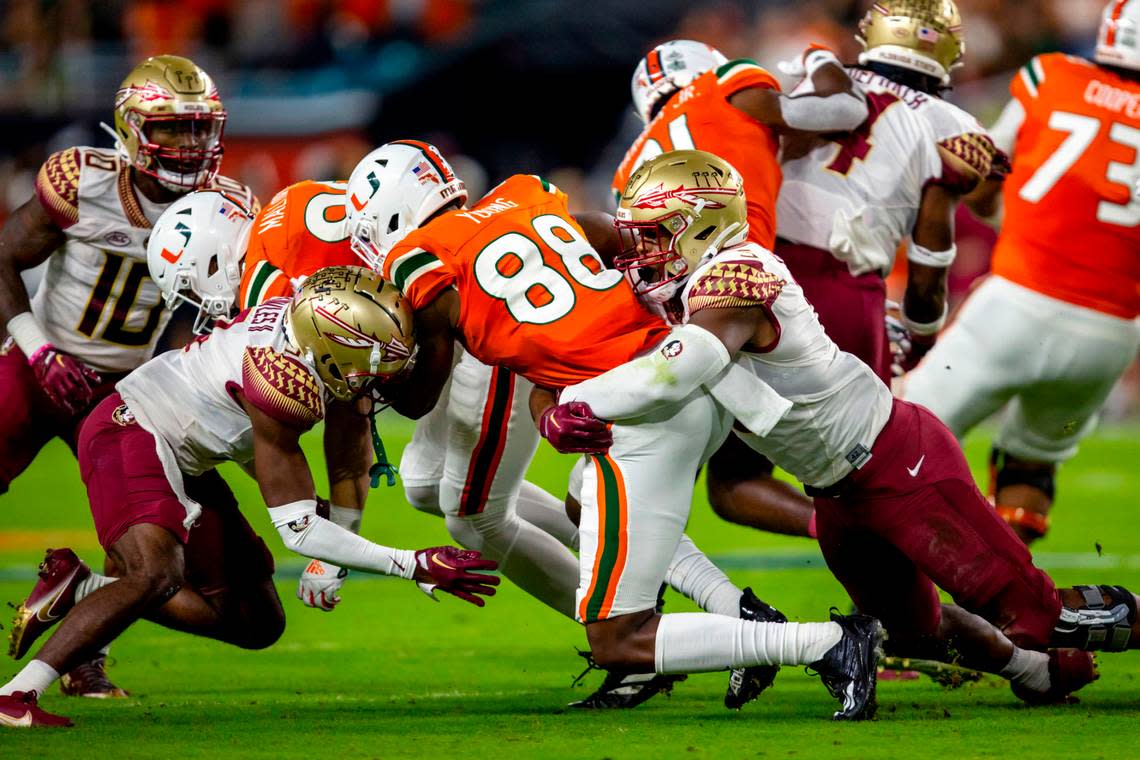Miami learns opponents and protected rivalries when ACC grows to 17 teams in 2024

The newest Atlantic Coast Conference puzzle is complete.
In other words: California, here they come.
The ACC on Monday night released its new schedule format for the league that will grow to 17 teams when SMU, Cal and Stanford join next season. UM learned that it will already be traveling to Berkeley, California next season to play at Cal, and will play at Stanford in 2026, at Cal again in 2029 and at SMU in 2030.
And to assuage the worries of fans who thrive on the annual Miami-Florida State rivalry, the Hurricanes and Seminoles will continue to be yearly opponents in what is now being called a ‘protected rivalry.’
Also: back on a yearly basis as the other protected rivalry for the Hurricanes: Virginia Tech.
The ACC released each member’s league opponents from 2024 through 2030. The conference will have no divisions, as that format was already instituted this season.
Following are Miami’s ACC opponents for 2024 through 2030, with schedule dates to be released at 9 p.m. Jan. 31 on the ACC Network:
2024: Home — Duke, FSU, Virginia Tech, Wake Forest. Away — Cal, Georgia Tech, Louisville, Syracuse.
2025: Home — Louisville, NC State, Stanford, Syracuse. Away — FSU, Pitt, SMU, Virginia Tech.
2026: Home — Boston College, FSU, Pitt, Virginia Tech. Away — Clemson, North Carolina, Stanford, Wake Forest.
2027: Home — Cal, Georgia Tech, Louisville, Virginia. Away — Duke, FSU, NC State, Virginia Tech.
2028: Home — Duke, FSU, Stanford, Virginia Tech. Away — Boston College, Pitt, Syracuse, Virginia.
2029: Home — Clemson, UNC, SMU, Wake Forest. Away — Cal, FSU, NC State, Virginia Tech.
2030: Home — Boston College, FSU, Georgia Tech, Virginia Tech. Away — Clemson, UNC, SMU, Virginia.
In June 2022, the ACC released what was then its new football schedule model for 2023-2026, but will soon be obsolete.
The top two teams, based on conference winning percentage, will still compete in the ACC Football Championship Game on the first Saturday in December at Bank of America Stadium in Charlotte, North Carolina.
The new model will continue with each ACC team playing eight conference games per season, with all 17 teams playing each other at least twice over the next seven seasons — once at home and once on the road. The current 14 ACC teams will play a total of three times apiece in California over the seven years and none will travel to California in back-to-back seasons.
UM starting center Matt Lee, a fifth-year redshirt junior expected to enter the draft after this season, said on Tuesday he hasn’t paid a lot of attention to conference realignment, but “more power to ‘em.’’
“I’ve never been to California, never been out that far west. So, that’s pretty cool. It’s a long flight. Now that I look back after starting 45 games or whatever thus far in my collegiate career, it’s like, ‘Dang, I’ve been to this state and this state and this city and I got to see a little bit of a lot of different areas.’
“But in the moment, like this weekend when we go to North Carolina, I’m not going to be like, ‘Ooh, I’m in North Carolina.’ I have a football game to play. That’s what my mind is on.”
Canes starting defensive end Rueben Bain, a true freshman, said he didn’t even know about the new ACC format.
“Definitely exciting,’’ Bain said. “I guess when it comes to that point, new opportunities.’’
The model used for this year has each of the 14 league members playing three primary opponents. UM’s primary opponents: FSU, Louisville and Boston College. Had the model still been in use for the future, it was set to have each league member playing the other 10 ACC teams (not including the three primary opponents) twice — once at home and once on the road — during a four-year cycle.

